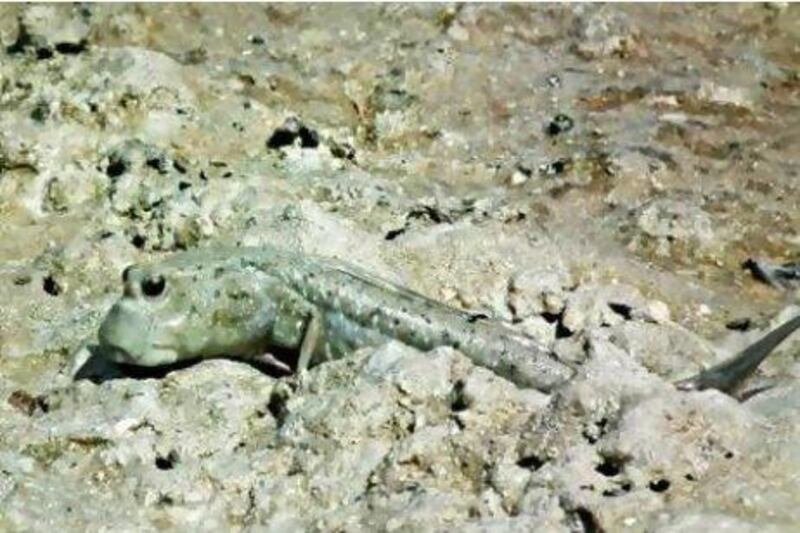DUBAI // A fish that walks on land has been spotted in the UAE for the first time in 35 years, according to two Dubai naturalists.
The Walton's mudskipper, known to experts as Periophthalmus waltoni, lives on mudflats in the intertidal zone of coastal lagoons.
It spends most of its time out of the water, propelling itself through the mud using its fins, or hiding in burrows in the mud.
The fish grows to about 15 centimetres and feeds on snails and insects on the damp surface when the tide is low.
The sighting was made by Dubai-based naturalists Binish Roobas and Gary Feulner.
"The mudskipper's reappearance is a rare bit of good environmental news against a background of continuing habitat loss in the UAE's coastal regions," said Mr Feulner, a long-time resident and naturalist who is a frequent visitor to the country's coastal lagoons.
Periophthalmus waltoni is found in the Northern Arabian Gulf, the Strait of Hormuz and as far away as Pakistan. But in the UAE, the last sighting recorded by scientific observers was in the mid-1970s.
This is why Mr Roobas was so surprised when he spotted the fish. The naturalists would not reveal where they saw the creature because they want to protect the species.
"We were walking across a patch of muddy ground when Binish asked me curiously, 'Do we have mudskippers here?'," said Mr Feulner. "He had surprised some animal that made a short dash into a burrow. It was not a crab.
"Binish is an excellent observer and when he described a six-inch fish, I knew there could be only one possibility. He had to be right."
The pair left the area for a few minutes to let the fish's fear subside. They returned, slowly and quietly, a few minutes later, and saw a mudskipper in full view beside its burrow.
"We soon saw others and watched one gulp a fly. They are unmistakable," said Mr Roobas, who has a degree in zoology from his native India but who works in Dubai in the hotel industry.
An ungainly but endearing creature, the mudskipper was easy to identify from pictures and descriptions in scientific literature.
Its two bulbous eyes, set on top of its head, give it a peculiar appearance but a nearly 360-degree view of its environment.
Periophthalmus is a compound name from the Greek 'peri' (around) and 'ophthalmôn' (eye), which refers to the wide visual field of the species.
They are ambush predators and can pounce with great speed, grabbing small crabs or insects. They can also flee rapidly to their burrows when surprised and can leap into the air.
"I always wanted to see mudskippers but I thought I would have to go to the tropics to do it," said Mr Roobas. "It is a very interesting fish and I hope we can help it to survive here. The population is small but we hope to be able to find others."
The discovery raises a number of questions that the naturalists hope to answer.
One is whether mudskippers could be found at other UAE sites.
Another is whether the mudskipper has really been gone all this time, or if the small remaining populations have simply gone unnoticed.
"It is difficult to imagine that the presence of such a creature could be missed by the legions of professional consultants and amateur naturalists who have scoured the UAE's coastlines since the 1970s," said Mr Feulner. "But it is even more surprising if it has re-appeared recently, because its habitat, the intertidal periphery of coastal lagoons, has been a prime target for dredging or 'reclamation' by development projects.
"What factors could have allowed or encouraged the mudskipper to return under these conditions?"
Whatever the answer, the discovery once again highlights the importance of preserving coastal mudflats, which are ignored in most conservation efforts. The mudskipper site is within what is considered a protected area, but it has been subjected to disruption by infrastructure projects.
Nearby, additional commercial development is planned.
"From a human perspective, these areas are seen as waste ground," said Mr Feulner. "But from a biological perspective, they are an integral part of the rich, interconnected ecosystem of the coastal lagoons, mangrove forests and adjacent seas."





